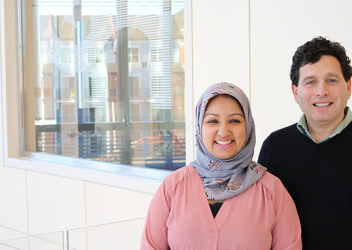Research In Action
Research In Action
Breadcrumb

Author's note: Today marks National Gun Violence Awareness Day and the start of Wear Orange Weekend, an annual event led by Moms Demand Action and Everytown for Gun Safety that is dedicated to remembering the lives lost to gun violence and to raise awareness about this public health crisis. The following is a repost from Where Discovery Leads, a multimedia storytelling project that explores key research themes at the Children’s Hospital of Philadelphia Research Institute. This edition is focused on CHOP research that has informed gun violence prevention efforts. For the full post, click here.
For the first time in decades, more children died from guns than from motor vehicle crashes, making firearms the number one cause of death for children in the United States in 2020. Seven children are killed and eight are injured by gunfire every day in America, and youth firearm suicide has reached its highest rate in more than 20 years, with most cases involving a family member’s unlocked weapon.
For Joel Fein, MD, MPH, an attending physician in the Emergency Department at Children’s Hospital of Philadelphia (CHOP) who conducts youth violence prevention research, the statistics are both staggering and, to some degree, inconsequential — one preventable pediatric injury or death is one too many.
“In reality, it does not matter if firearms are the first, second, or third leading cause of death, because it is all ridiculously tragic,” said Dr. Fein, who also co-directs CHOP’s Center for Violence Prevention with Stephen Leff, PhD. “It is incumbent upon CHOP, as a pediatric institution, to address the issue, in partnership with communities and community-based organizations.”
When it comes to preventing firearm injury and death, the home is one of the places CHOP researchers focus to help inform effective interventions to keep children safe from unsecured firearms. They’re also using evidence-based research to demonstrate how exposure to gun violence negatively affects the mental health and well-being of our country’s youth. And they’re sharing knowledge about trauma-informed practices with community groups affected by gun violence.
As a pediatrician at CHOP’s South Philadelphia Primary Care practice for the past 24 years, Dorothy Novick, MD, has seen firsthand how violence can be a self-perpetuating cycle: A rise in community violence often leads to an uptick of guns inside of the home, which has been shown to significantly increase suicide and unintentional deaths of children and teens.
“The more worried you are about your safety, the more likely you are to purchase a gun and to keep it where you can easily access it for protection — your car, on top of the refrigerator, under your pillow,” Dr. Novick said.
A report from Everytown for Gun Safety shows there were 2,070 unintentional shootings by children in the United States between 2015 and 2020, and seven in 10 of those occurred inside the home. Additionally, shootings by children are most often also shootings of children: 91% of those victims were under age 18.
CHOP Research Sets Stage for Safety Counseling
CHOP’s Gun Safety Program offers a harm-reduction approach to gun safety that focuses on meeting patients and their caregivers where they are. The idea for the program began during a 2017 Center for Violence Prevention retreat involving CHOP clinicians, researchers, and staff.
The group collectively identified gun violence as a critical issue to focus their attention, and they decided to try gun safety counseling and safety device distribution as an intervention. Research shows that storing firearms securely plays a vital role in reducing unintentional shootings and gun suicides.
Sofia Chaudhary, MD, an emergency medicine physician in Atlanta, was an ED fellow at CHOP at the time of the retreat. She and Dr. Fein launched a qualitative study to assess the feasibility and acceptability of firearm safety counseling and distribution of safe storage devices in the ED at CHOP’s Philadelphia Campus.
During the course of the study, caregivers of patients visiting the ED completed a survey on firearm safe-storage knowledge and practices, and they received firearm-safety education. Among those with handguns, 17% reported not using a safety device, and 17% reported storing the gun loaded. The research team offered free cable locks and device education to those with firearm access — 47 individuals, 15% of all study participants, went home with one or more cable locks. A member of the study team contacted participants two weeks after the ED visit to assess firearm safety practices, cable lock use, and acceptability of the intervention.
“Our research found that parents and caretakers are usually appreciative and do not mind being asked about guns, at least in the emergency department and our primary care clinics,” Dr. Fein said. “We’ve also shown that if we do give education to parents and caretakers, we can increase the safe storage of guns in the homes where our young patients live and play.”
To continue reading Part One, click here.
Watch an accompanying video featuring CVP co-director Joel Fein, MD, MPH.



